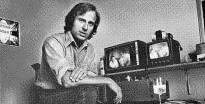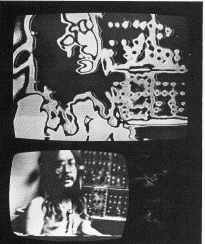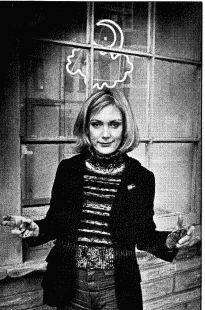|
Tedwilliam
Theodore
Tedwilliam Theodore's
activities are too numerous to list here, but they're all community-based,
goal-oriented, social action projects. He does most of his work under the
aegis of his nonprofit corporation Communications for Change, a consulting
firm which helps organizations develop "economically and
programmatically viable" uses of videotape. Tedwilliam's goal is
helping people use tape by and for themselves. He's quick to point out
that he doesn't do alternative video to replace broadcast television - or
even use it. Call it closed-circuit TV, direct-application TV, or
small-application TV, his use of tape is always within a small group.

By his own definition, Tedwilliam does two
kinds of projects. Those which he describes as "social action"
include confrontation and resource
development. "Social welfare"
projects train social agencies to use tape for their purposes - in staff
training, counseling, community outreach, and inter-agency communication.
Tedwilliam's career as a videotape consultant
began with a lucky coincidence. In 1966, as a graduate student at the
University of Chicago, he took a part-time job in the Education Department
as a photographer. That was the year industrial format tape equipment was
first marketed. The University bought some, and he was the likely person
to experiment with it. He produced tapes for the Independent Learning
Project and the Master of Arts in Teaching Program.
In 1969, the Woodlawn Mental Health Center
hired Tedwilliam, still a graduate student, to use
tape in preventive mental health and community outreach programs. He taped
meetings and played them back at other meetings. During two years there,
he felt he was "working blind" in the absence of conclusive data
from other experiments. But he was learning from his experience and
others', particularly the Canadian "Challenge for Change"
Program.
The need for new approaches to community
problems increased daily. Tedwilliam began free-lancing his skills to
mental health organizations, including the School Intervention and
Training Program (at the University of Chicago) and the Children's Center
for Learning Capacities.
Community Programs set up Communications for
Change in May of 1972, with Tedwilliam as director, to explore the use of
new tape techniques in Chicago communities. Its funding soon ran out, at
which point it became an independent firm working with many of the same
agencies.
Because his main objective is to help people
themselves with video, Tedwilliam teaches video often. He's given
workshops and demonstrations at Governors State University and the
Community Arts Foundation, and is now conducting Videotape Workshops at
Loop College.
You have to be versatile to support yourself
and your wife doing video- Tedwilliam is amazed that he's done it for the
last year. But he shouldn't be. He's on the ground floor of a movement
that can only grow larger with time.
Dan
Sandin

For Dan
Sandin, Assistant Professor of Art at Circle, the way to do
television is to build a machine called the Image Processor. It's a
"patch programmable general purpose analog computer, optimized for
the real time processing of video images."
In less technical terms, the Image Processor is the visual equivalent of
the Moog Synthesizer. Dan feeds video images (or anything that can be
coded electronically) into it. Through manipulation of its controls, the
machine alters the image and displays it on a television screen. The
result can be videotaped.
The Image Processor is the most sophisticated machine of its type on the
planet. While more primitive visual synthesizers, the most famous being
the Paik/Abe Synthesizer, are capable of limited alteration of images (the
Paik/Abe combines and colorizes), the Image Processor can modify images in
virtually any way. It combines
images, colorizes them, processes them (changes their form) - it even
generates them from scratch. It's also the first and only visual
synthesizer to
be
modular in design, which means it can be easily adapted to any input.
Dan is a nuclear physicist. But, like many of Chicago's video freaks, his
avocation became his occupation. After receiving his M.A. in Nuclear
Physics from the University of Wisconsin in 1966, Dan designed light shows
for fun (and negative profit). Then he took a job as a researcher at
Wisconsin, but soon "it became clear to me that what I really wanted
to do was something visual, something that involved more of my being than
physics." He did some photographic exhibitions, some light sculpture,
then began looking for a college teaching position in Art. Circle hired
him.
With a $3,000 grant from the University for "innovations in undergraduate
curriculum," Dan built the Image Processor during the 1972-1973
academic year. By the end of January, he was able to inaugurate it with
"In Consecration of New Space," an improvisational visual work
in collaboration with Jim Wiseman and Phil Morton of the Art Institute.
Since January, the trio has exhibited the I mage Processor around the
country. In their first appearance on broadcast television, they taped a
segment for Channel 11's "Made in Chicago."
The I mage Processor represents a major shift in Dan's work from
"single purpose art objects" to "general purpose systems
embodying a large number of possible uses." The two fundamental uses
of the Image Processor are as a learning tool and as a vehicle for
communication.
It's the individual operator's learning experience that most interests
Dan. He refers to the Image Processor as "a tool for personal
growth." Just as playing a musical instrument affects the life of a
musician, using the Image Processor affects the way the user sees the
world. Dan says the process of using any technology profoundly affects the
user.
As far as Dan's concerned, the production of art as well as potential
broadcast applications of the Image Processor are secondary and merely
coincidental to its effect on the individual. That's why the machine is
always available to his students. He thinks extensions of the Image
Processor concept will be the teaching machines of the future. To replace
the "antiquated interrogation procedures" of today's
computerized instruction, man will develop "a very powerful machine
that you control to find out things about yourself and your
universe."
It will be more efficient than previous kinds of learning. The Image
Processor's capability of altering images in real time, without lapse
between conception and realization, is an important one. Actually, there
is an infinitesimal gap, a matter of microseconds. But compared to the
length of time between conception and finished film, or conception and
finished painting, or conception and finished novel, the processing of
images in real time is a significant breakthrough. "You can go
through a set of experiences with the Image Processor in an
afternoon," says Dan, "that would take, using any other
technology, weeks or months."
The time of mass use of machines like the Image Processor for personal
growth is probably not far in the future. Despite his knowledge of nuclear
physics, Dan has no formal training in electronics. He was able to design
and construct the Image Processor because the technology of integrated
circuits has become so simple that virtually anyone can use it
creatively. The Image Processor is just one of many such machines under
construction. And it is so simple to operate that anyone can learn in a
few hours. Soon children may play with image processors and synthesizers
instead of Erector sets.
HYDE PARKER 51
Anda Korsts
 Former
radio newsperson Anda Korsts organized Videopolis, a "community video
access project," early this year. It's a non-profit, tax-exempt
corporation designed to make sure that Chicago appreciates the potential
and explores the possibilities of half-inch tape before cable arrives. Former
radio newsperson Anda Korsts organized Videopolis, a "community video
access project," early this year. It's a non-profit, tax-exempt
corporation designed to make sure that Chicago appreciates the potential
and explores the possibilities of half-inch tape before cable arrives.
If Videopolis is any indication, Anda has a
great future in underground TV. As Ken Englund of the Illinois Arts
Council staff puts it "Nothing gets in her way!" Her ability and
aggressiveness has enable her to involve organizations as diverse as the
Arts Council, the North Lawndale Economic Development Corporation, and the
Latvian magazine Mazputnins in the project.
In Anda's words, Videopolis is Chicago's first
"comprehensive video project." It provides information about,
and access to, video. Loop College, the
Chicago Board of Education, and Urban Gateways
of Chicago have utilized Anda and her two partners in Videopolis, Lilly
Ollinger and Jack McFadden, to train people in the use of video equipment
and to study the feasibility of using video as an adjunct to their
programs.
The group's more specific focus for this year
is experimentation with five uses of tape: education, community
organization, arts documentation, historical documentation, and archiving.
Because it's the first group in Chicago
organized to meet the need for various kinds of
experimentation, Videopolis has formed associations with some of the
city's most vital institutions: It is investigating tape's community
organization potential with the Citizens Action Program and documenting
the history of Hull House. With Studs Terkel, Videopolis is studying the
possibility of putting books like Division Street: America and Hard Times
on videotape.
And Videopolis has accomplished some firsts.
In the area of arts documentation, it has been developing a series of
programs about the "Chicago School" of artists, the first
significant effort to document these artists and their work. Videopolis
helps each artist to produce his own tape. The initial one-hour tape was
shot in Ed Paschke's home. Videopolis has also preserved some of the
Lincoln Avenue theater scene for posterity by taping the Organic Theater's
Warp and well as Turds in Hell, Muzeeka, and Saved at the Kingston Mines
Theater.
But these are only a few of Videopolis's
liaisons in the Chicago community. It's constantly working to accumulate
more, in Chicago and around the country. Last year Anda attended most of
the major gatherings on cable TV and alternative media. Videopolis
maintains extensive print and tape libraries, circulates a newsletter, and
sponsors regular tape showings.
The basic funding of Videopolis -- $23,000 for
one year -- comes from the Arts Council, the Wieboldt Foundation,
and the University of Illinois at Chicago Circle. Although it would pay
for only one hour-long filmed documentary at Channel 11, the $23,000, plus
about $2,000 from organizations given access to Videopolis, will pay for
equipment, salaries, tape, and other expenses for one year. Videopolis is
a special program in Circle's College of Urban Studies (the University's
coordinator is veteran Chicago filmmaker Jerry Temaner), which status
entitles it to the use of sophisticated editing facilities and an
institutional framework for the distribution of videotapes.
tour years ago, Anda Korsts covered the City
Hall beat for WBBM Radio. She didn't like it, with one exception.
"The Convention in '68 was great. But I had my assignment. I realized
when I was done that I knew almost nothing about the Convention."
After leaving WBBM, she worked with
Michael Sham berg, author of Guerrilla Television (a guide to alternative
video) and a member of Raindance, a pioneering video cooperative in New
York City. Anda and Shamberg had once worked together as reporters at
Chicago's City News Bureau.
Last year Anda was a part of Top Value
Television, a group coordinated by Shamberg which utilized half-inch
equipment to cover both political conventions. Now known as TVTV, it
marketed three tapes of the conventions to several cable companies and
broadcast stations (including Channel 11 in Chicago). Anda appreciated the
ability to shoot a virtually unlimited amount of tape and the lack of
necessity to drag a union crew along with her as she shot. She feels she
knows something about the 1972 conventions. And she learned something
about the nature of the new medium in contrast to broadcast television or
radio: "Because it's inexpensive and mobile, you don't have to plan,
as opposed to the planning that's done in broadcast TV or film. You don't
have to decide on an interpretation before you cover an event. It's closer
to writing. With writing, you take notes about everything. You go back
afterwards and find the quotes or descriptions that are most suggestive.
Similarly, with half-inch tape, you can just keep on taping."
Anda's background is in painting. But she
loves the process of using tape, especially if its allowing her to be
relatively self-sufficient - she can use both camera and microphone at
once. She intends one day to do "very personal video art."
52 HYDE PARKER
Kaye Miller
Kaye Miller and Roberta Kass (at
right) 
Kaye Miller, Instructor in Political Science at Circle, approaches
video more analytically than anyone else I've met. Perhaps that's because
his field concerns itself more with messages than with the media in which
they're presented.
In the mid-60's, Kaye experimented with film as a graduate student at
Berkeley. In 1968, at Circle, he and sociologist Gerry Swatez developed a
project that indulged their interests both in film and in research - a
film study of the '68 Democratic Convention. Proposing to "preserve
the concrete," they received funding and a considerable amount of
technical assistance from Circle. Taking two years to complete, the film
won prizes at the Venice and Chicago Film Festivals and the Edinburgh
Festival.
With their first film as a sales point, Kaye and Gerry began seeking
funding for new film research. None was available. But, having completed
construction on several buildings in 1970, the University did have funds
for equipping the buildings. While film stock was an "expendable
supply" and processing an expense, tape equipment and reusable tape could be coded
as equipment. That budgeting peculiarity turned them into tapemakers.
Showing their Convention film at meetings of various professional
associations, they had become intrigued by that kind of convention and
puzzled by its appeal. So they taped the 1971 Convention of the American
Political Science Association in Chicago. In the process of shooting 150
hours of tape for a one-hour product, they learned a great deal about
tape.
During the 1971-1972 academic year, Kaye began experimenting with the
"consciousness raising" potential of tape with five community
organizations (particularly the Young Patriots Health Clinic in Uptown).
He taught these organizations to look at the reality of their communities
with tape. At the end of the academic year, with this work incomplete, the
state budget was cut and his funding collapsed. In drafting the budget, no
contingency plans had been considered for projects in progress.
Kaye is now devising projects with his most recent tape collaborator,
Roberta Kass, a former political and union organizer. They want to
discover "how one can use a medium that represents surfaces to get at
the insides of things. We want to develop," says Kaye, "modes of
making film and tape that speak adequately for the world they represent.
The problem is to make them speak for both the surface and the
inside." Their most provocative idea, which is now just an idea, is a
project that will "get inside" the world of children. They're
searching for the best ways of using the language of tape. Their concern
for more effective use of the medium has led Kaye and Roberta to edit this
month's issue of Radical Software, a national magazine devoted to
alternative video technology. In it, they've initiated the arduous process
of developing a language of criticism appropriate to tape by reviewing
past issues of the magazine itself and tapes by major tapemakers.
The idea of a critical issue provoked strong negative reactions.
Several influential tapemakers refused to submit their
efforts, saying that tapes aren't meant to be criticized or that criticism
is authoritarian.
But Kaye and Roberta believe criteria for evaluating tape are
necessary. As a tapemaker, Kaye says "you need to make and you need
to criticize. It's through the critical process that you begin to discover
the possibilities of the medium, its characteristics, and what can and
cannot be done."
Roberta supports this thesis in her introductory article, and sounds a
warning: "To keep silent about serious things will allow the
conventional and corrupt forces of public opinion, the state, and business
to swoop up the meanings and definitions. . . The new experiences we have
had are much too precious to subject to the twisted meanings of the old
culture which wildly attempts to absorb anything which even vaguely
threatens change."
|